Trees Birds Mammals Fish Amphibians Reptiles
Wild Algarve
Bookshop
Hygrocybe miniata (Fr.) P. Kumm. - Vermillion Waxcap
Phylum: Basidiomycota - Class: Agaricomycetes - Order: Agaricales - Family: Hygrophoraceae
Distribution - Taxonomic History - Etymology - Identification - Culinary Notes - Reference Sources
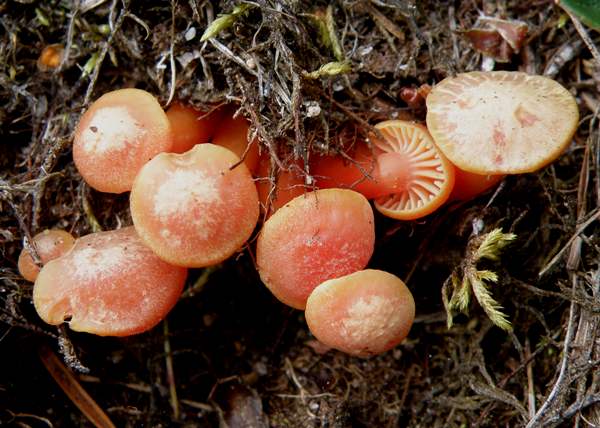
One of the smaller species of red waxcap fungi, Hygrocybe miniata is an infrequent find on cropped grassland and in woodland clearings.
Red waxcaps are notoriously difficult to separate on macroscopic characters alone, and so it is a great help when a species has one or more features shared with few or no other waxcaps. The Vermillion Waxcap is one very few members of the Hygrophoraceae whose caps are scurfy rather than greasy.
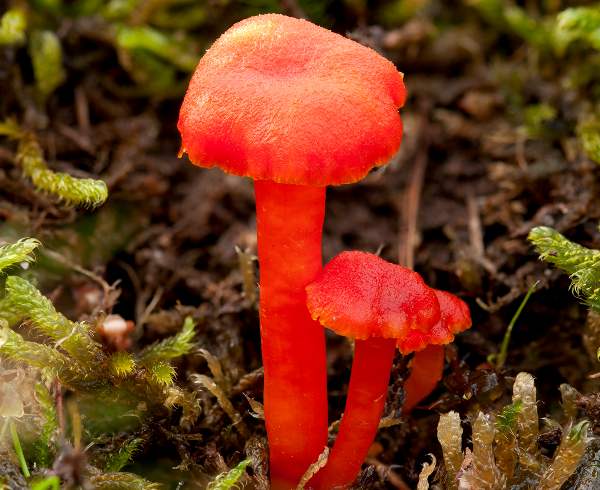
Distribution
The Vermillion Waxcap is an uncommon find but widely distributed in most parts of Britain and Ireland. This species has pretty much a worldwide distribution in temperate regions, although in some countries it is more commonly found in woods than on grassland and heathland. Hygrocybe is recorded in most parts of mainland Europe and Asia as well as North America, Australia and many other countries.
Taxonomic history
When pioneering Swedish mycologist Elias Magnus Fries was writing Systema Mycologicum (published in 1821), he described this waxcap scientifically and gave it the name Agaricus miniatus. (At that time most gilled fungi were initially placed into the genus Agaricus, since cut down to a more manageable proportions by redistribution of most of its contents to other genera, including Hygrocybe.) Despite literature searches by other mycologists over the past two centuries, the basionym remains unchallenged. It was German mycologist Paul Kummer who, in 1871, transferred this species to the genus Hygrocybe, establishing its current scientific name Hygrocybe miniata.
Hygrocybe miniata has acquired several synonyms including Agaricus miniatus Fr., Hygrophorus miniatus (Fr.)Fr.,
Hygrocybe miniata var. miniata (Fr.) P. Kumm., Hygrophorus strangulatus P. D. Orton, and Hygrocybe strangulata (P. D. Orton) Svrcek.
Etymology
The genus Hygrocybe is so named because fungi in this group are always very moist. Hygrocybe means 'watery head'. Does the specific epithet suggest to you that this is a very small waxcap? That's exactly what miniata means.
Identification guide
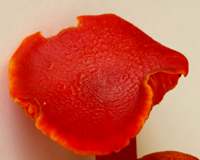 |
Cap
The dry, scurfy cap, typically 1 to 3cm in diameter, is at first convex and then flattens sometimes with a slight depression; initially scarlet or blood red; with age the cap fades from the margin inwards to orange and then to yellowish, also becoming smoother. The cap flesh is thin and reddish-orange. |
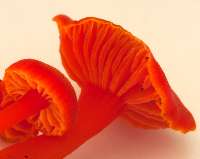 |
Gills
Reddish-brown with pale yellow edges, the gills are adnate, sometimes with a decurrent tooth; broad and fairly distant.
Stem
Scarlet or orange-red but paler at base, the dry stipe is level, 0.3-0.5cm diameter and 2-7cm talll; no stem ring; reddish-orange stem flesh. |
| |
Spores
Ellipsoidal, smooth, 6.5-9 x 4-5μm; inamyloid.
Spore print
White. |
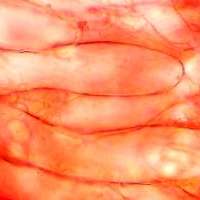 |
Gill Trama
Subparallel - see photomicrograph, left.
|
Odour/taste |
Not distinctive. |
Habitat & Ecological role |
Woodland clearings and closely cropped or mown acid grassland where artificial fertilisers are not spread; also sometimes found on sandy heathland.
Waxcaps have long been considered to be saprobic on the dead roots of grasses and other grassland plants, but it is now considered likely that there is some kind of mutual relationship between waxcaps and mosses. |
Season |
September to November in Britain and Ireland. |
Similar species |
Hygrocybe cantharellus has decurrent gills.
Hygrocybe coccinea has a larger orange-red cap.
Hygrocybe conica turns black with age or when cut. |
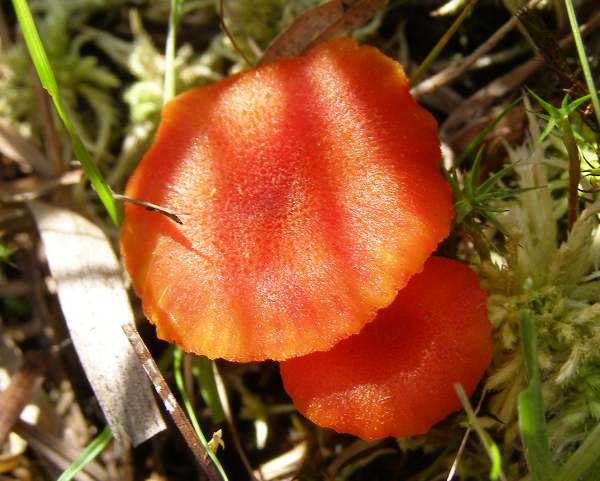
Culinary Notes
The Vermillion Waxcap is reportedly edible, but it is too small and insubstantial as well as too uncommon to be worth considering as a culinary collectible. It is, however, a very fine feast for sore eyes.
Reference Sources
Fascinated by Fungi, 2nd Edition, Pat O'Reilly 2016, reprinted by Coch-y-bonddu Books in 2022.
Fungi of Northern Europe, Volume 1 - The Genus Hygrocybe, David Boertmann, 2010.
Dictionary of the Fungi; Paul M. Kirk, Paul F. Cannon, David W. Minter and J. A. Stalpers; CABI, 2008
Taxonomic history and synonym information on these pages is drawn from many sources but in particular from the British Mycological Society's GB Checklist of Fungi.
Acknowledgements
This page includes pictures kindly contributed by David Kelly.
Top of page...
Fascinated by Fungi. Back by popular demand, Pat O'Reilly's best-selling 450-page hardback book is available now. The latest second edition was republished with a sparkling new cover design in September 2022 by Coch-y-Bonddu Books. Full details and copies are available from the publisher's online bookshop...